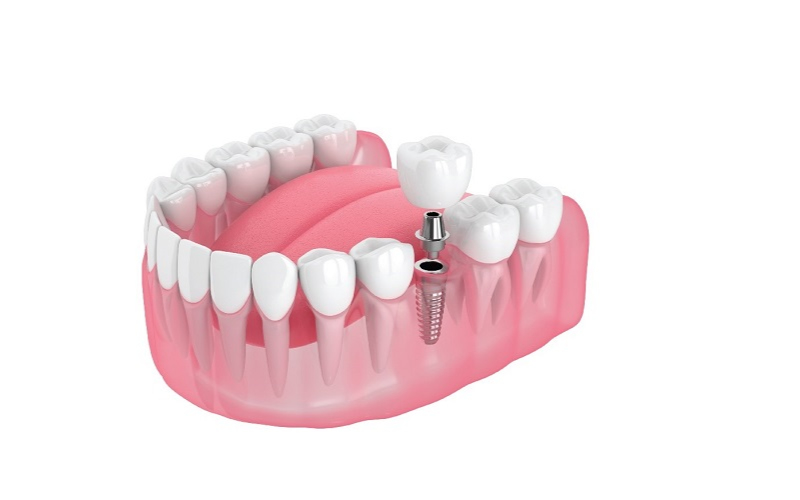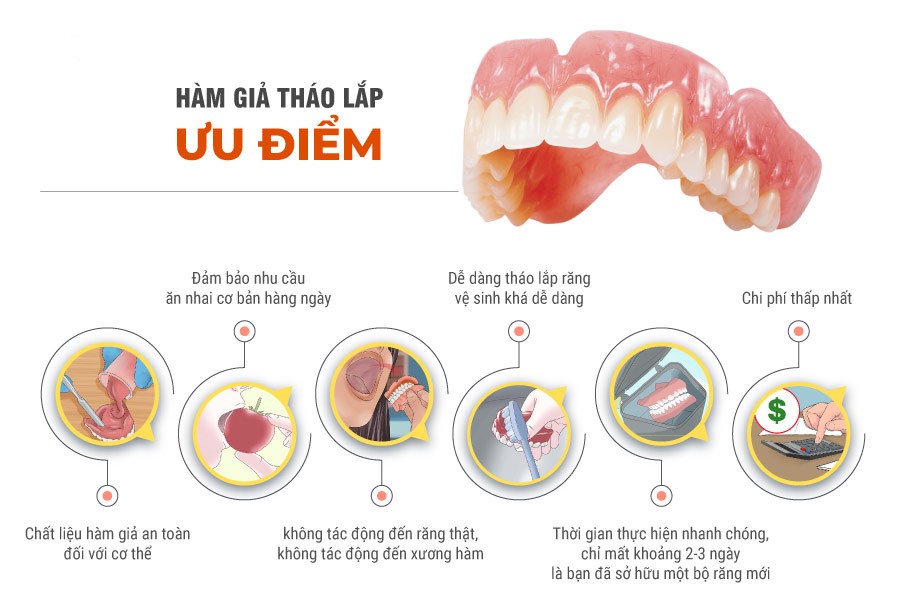Tooth loss not only affects aesthetics but also causes many problems related to oral health and chewing function. Among the current tooth restoration methods, dental bridges are considered a popular solution chosen by many, helping to restore lost teeth naturally and durably. So, what is a dental bridge? Is getting a dental bridge a good option?
What is a dental bridge?
A dental bridge is a method of replacing missing teeth, used in cases of one or two lost teeth. It works by bridging the gap using two crowns placed on the adjacent teeth. The bridge consists of two crowns attached to the ends of the gap and one or two false teeth (depending on the number of missing teeth) placed in between. The two healthy teeth on either side are trimmed and covered with crowns to act as abutments.
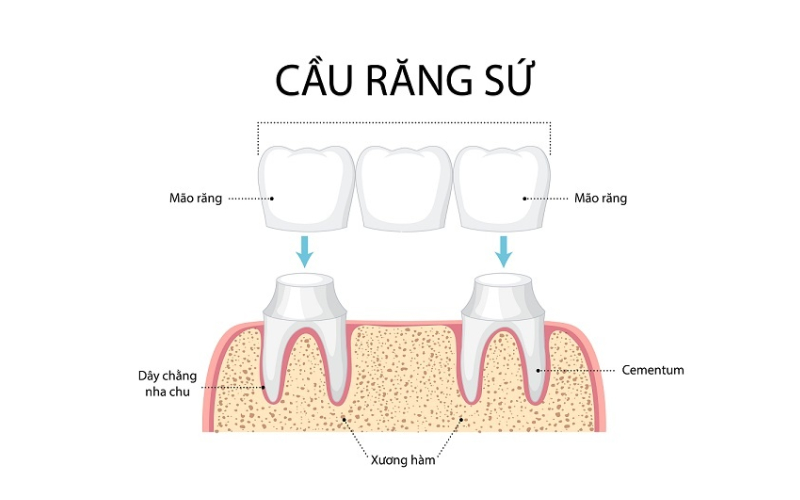
Similar to dental crowns, there are various materials used to make bridges, such as: cercon, titanium, metal, zirconia, diamond, and emax… Depending on the location of the missing tooth, your needs, financial capability, and oral condition, the dentist will advise the most suitable type. All-ceramic types like diamond, zirconia, cercon, and emax offer high aesthetics and durability. Meanwhile, titanium and metal bridges are more cost-effective.
Common types of dental bridges
There are many types of dental bridges, each with its own advantages and disadvantages. Below are some popular types:
Traditional dental bridges
Traditional dental bridges are quite common. The abutment teeth are healthy teeth on either side of the missing tooth. The dentist will trim the abutment teeth to make room for a dental crown to fit over them. Between the abutments, a false tooth (pontic) is attached to the crowns, replacing the missing tooth.
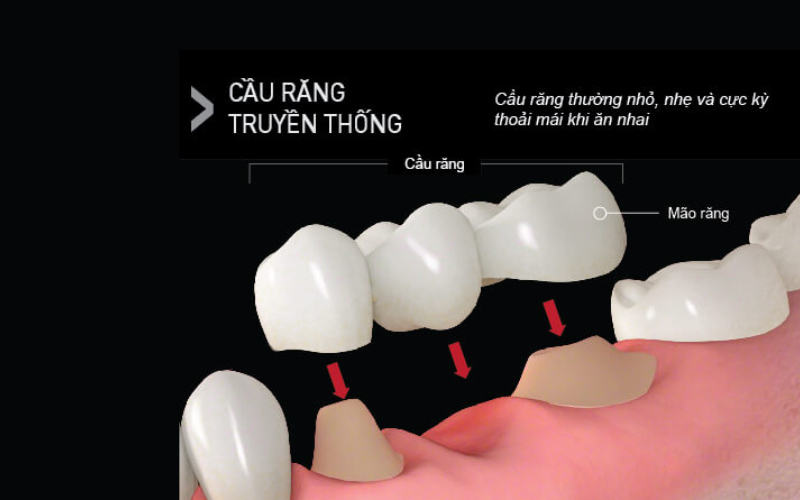
Cantilever bridges
In this type of bridge, the dentist uses one or two abutment teeth located either in front of or behind the missing tooth. However, this type is not widely recommended because it can put excessive force on the abutment teeth if not carefully planned.
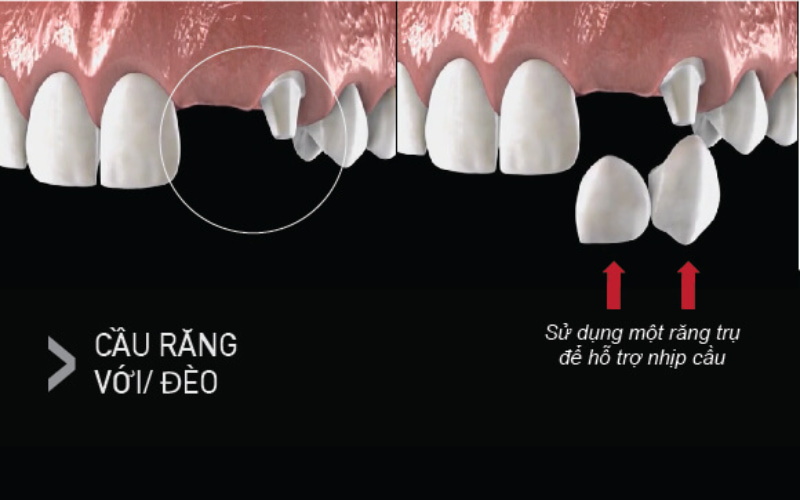
Maryland bonded bridges
This type of bridge helps preserve the abutment teeth by requiring minimal trimming. It consists of a porcelain false tooth with two wings (made of metal or porcelain) bonded to the back of adjacent teeth. The false tooth fills in the gap while the wings are fixed to the inner surface of the neighboring teeth.
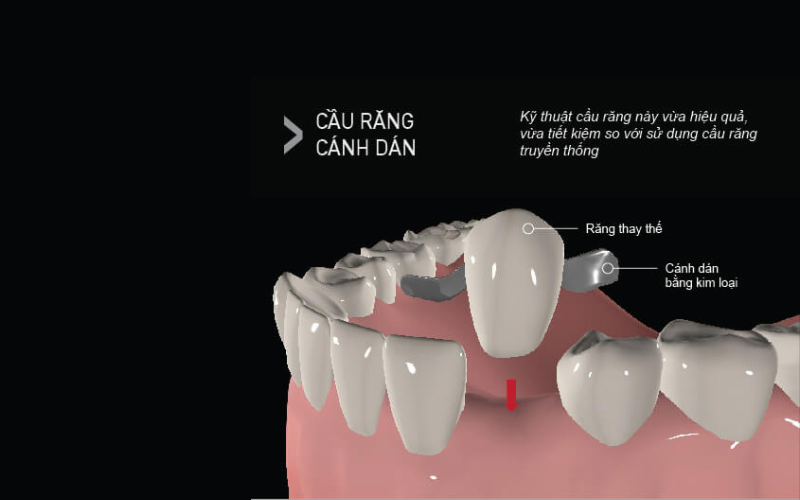
Implant-supported dental bridges
Instead of natural teeth, this type of bridge uses dental implants placed in the jawbone as abutments. Implant-supported bridges do not affect adjacent teeth and create proper spacing between teeth, helping the bridge remain stable and reducing jawbone loss.
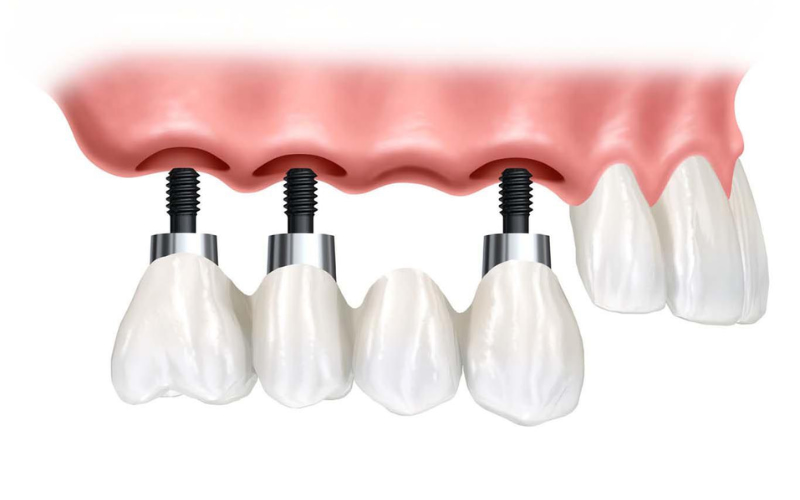
Advantages and disadvantages of dental bridges
Dental bridges are one of the most popular methods of tooth replacement today. However, like any other method, they have their own pros and cons. Specifically:
Advantages
- Quick procedure time – restores missing teeth in just 4–5 days, faster than implant placement.
- The bridge is fixed to the abutment teeth in the arch, providing a natural chewing sensation similar to real teeth.
- Dental bridges are strong and offer good chewing function, comparable to natural teeth.
- High aesthetics – porcelain bridges have natural tooth color and blend well with surrounding teeth.
- Do not cause irritation to tissues in the oral cavity.
- Non-metal porcelain bridges avoid “image noise” in X-rays, CT scans, or MRIs passing through the area.
- Restore other dental functions such as: normal bite alignment; improved speech and clearer communication; maintain natural facial shape.
- Prevent or eliminate other disadvantages caused by tooth loss such as: shifting of adjacent teeth; preventing temporomandibular joint disorders from missing teeth.
- Durability: dental bridges can last 7–10 years or more if properly cared for.
Disadvantages
- The natural teeth used as abutments need to be trimmed, which may lead to sensitivity or pulp damage over time.
- Abutment teeth may require additional procedures such as root canals or height adjustment to function properly.
- Not all missing tooth cases are eligible – strict requirements on abutment tooth health and load-bearing principles must be met.
- Initially, bridges can restore 60–70% of chewing efficiency, but this may decrease if abutment teeth weaken.
- Bridges only replace the visible crown of the tooth – they don’t replace the root, so they cannot prevent jawbone loss or gum recession, which may affect appearance and abutment strength over time.
- Cleaning under bridges is harder than for natural teeth. Poor hygiene may lead to bad breath, gum inflammation, decay of abutments, requiring bridge replacement.
Is getting a dental bridge a good option?
If you are missing several adjacent teeth, especially those important for chewing, a bridge may not fully meet your needs. Also, because a bridge replaces only the crown, not the root, it can’t prevent jawbone loss or gum recession from missing teeth.
Despite some limitations, there’s no need to worry if you choose this method. If abutments are carefully selected, the missing space is small, the dentist follows proper technique and bite force is calculated accurately — plus, if you maintain good oral hygiene — then a dental bridge remains a suitable solution, especially when implants are not an option.
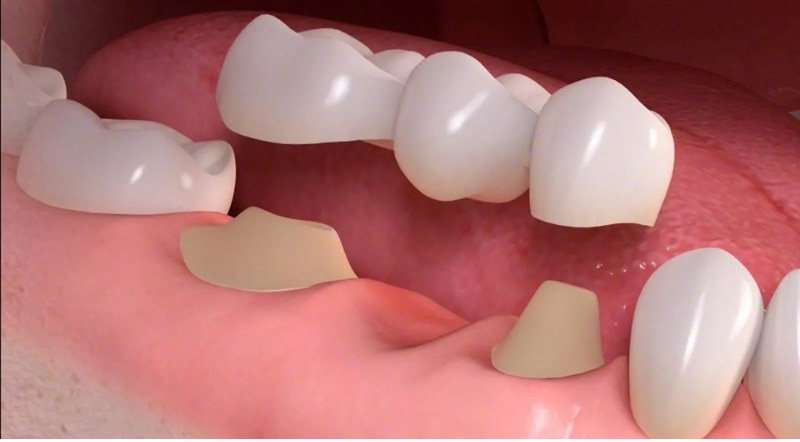
Who should get a dental bridge?
Thanks to advancements in dental materials, modern porcelain bridges closely resemble natural teeth in both strength and aesthetics. This makes dental bridges a popular option for replacing missing teeth in the following cases:
- Missing one or two adjacent molars.
- Missing teeth in between other teeth.
- Missing one or several front teeth.
- Using bridges over dental implants that have already been placed.
To determine if a dental bridge is the right option for you, your dentist will carefully evaluate your tooth loss situation and the following factors:
- Abutment teeth must be healthy and strong.
- The gums around the abutments must not be inflamed.
- The gum in the area of the missing teeth must be firm.
- Opposing teeth must be in good condition.
- If implants are used, they must be well-integrated into the jawbone and properly planned to support the bridge.
- Good oral hygiene practices must be in place.
- General health must be stable, with any chronic conditions well controlled.
Factors affecting the durability of dental bridges
Dental bridges can be affected by several bad daily habits. Below are some common behaviors that can reduce bridge lifespan:
Teeth grinding or sliding the jaw side to side while chewing: In addition to vertical bite force, teeth also endure bending stress, leading to bone loss around abutments. This can cause gum recession, pain, and mobility of the abutment teeth, potentially requiring bridge replacement.
Chewing only on one side: Overloading the abutment teeth on one side can accelerate gum recession, bone loss, and damage.
Jaw movement habits: If you often push the lower front teeth forward, the force may impact the front bridge area, weakening the abutment teeth and reducing bridge durability.
Food habits: Extremely hard or chewy foods can fracture or chip the porcelain, reducing both the lifespan and appearance of the bridge.
Oral hygiene: Proper oral hygiene is essential for protecting bridges. Brush after every meal, floss between teeth, and use a floss threader or water flosser to clean under the pontic. Brushing correctly helps prevent gum recession and enamel wear on abutment teeth.
Condition of natural teeth: If the abutment tooth is decayed or fractured, insufficient tooth structure may weaken the base. In such cases, your dentist may reinforce with a post or core before crowning. The dentist will provide a clear treatment plan and care guidance to maximize bridge longevity.
Is getting a dental bridge painful?
Getting a dental bridge is generally not very painful. However, the level of discomfort can vary depending on the individual and the dentist’s technique.
During the procedure: Before trimming the abutment teeth, the dentist will apply local anesthesia to numb the treatment area. This ensures you won’t feel pain during the tooth preparation and bridge placement.
Dentist’s technique: A highly skilled and experienced dentist will perform the procedure gently and accurately, minimizing trauma to the teeth and gums. Proper trimming also helps reduce sensitivity afterward.
After the bridge is placed: Once the anesthesia wears off, you may feel slight sensitivity around the abutment teeth. This sensation usually lasts only a few days and can be relieved with pain medication if needed.
Is a dental bridge durable?
The durability of a dental bridge is one of the main concerns for those considering this tooth restoration method. The lifespan of a dental bridge is similar to that of a dental crown—typically lasting from 7 to 10 years or even longer if maintained properly.
Safe and high-quality dental bridges at Amanda Dental Clinic
Amanda Dental Clinic is a reputable dental care provider trusted by many for dental bridge procedures.

- Highly qualified dental team: The dentists at Amanda Dental Clinic are experienced professionals in cosmetic dentistry. They perform procedures gently and precisely, giving you a beautiful and natural smile.
- Modern equipment: Amanda Dental is equipped with advanced tools and technology to ensure safety and efficiency. Especially noteworthy is the “1 dentist – 1 room – 1 patient – 1 set of tools” model, minimizing cross-contamination.
- High-quality porcelain materials: Amanda Dental uses premium porcelain materials with clear origins, ensuring durability and aesthetics.
- Professional bridge placement process: Dentists perform a thorough examination, recommend suitable methods, and provide a detailed treatment plan. The trimming and bridge placement are done with care, ensuring patient comfort.
- Thoughtful customer service: Friendly and dedicated staff are always ready to assist and answer all your questions. Clear warranty policies protect your rights.
Getting a dental bridge is an effective solution for restoring both aesthetics and chewing function. However, to ensure long-lasting, beautiful results, you should choose a reputable dental clinic with a skilled team. At the same time, proper oral care after getting a bridge is essential to preserve its appearance and longevity.




